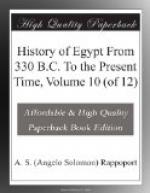Aristarchus, who had been the tutor of Euergetes II., and of a son of Philometor, was one of the ornaments of this reign. He had been a pupil of Aristophanes, the grammarian, and had then studied under Crates at Pergamus, the rival school to Alexandria. He died at Cyprus, whither he probably withdrew on the death of Philometor. He was chiefly known for his critical writings, in which his opinions of poetry were thought so just that few dared to disagree with them; and his name soon became proverbial for a critic. Aristarchus had also the good fortune to be listened to in his lecture-room by one whose name is far more known than those of his two royal pupils. Moschus of Syracuse, the pastoral poet, was one of his hearers; but his fame must not be claimed for Alexandria; he can hardly have learned from the critic that just taste by which he joined softness and sweetness to the rude plainness of the Doric muse. Indeed in this he only followed his young friend Bion, whose death he so beautifully bewails, and from whose poems he generously owns that he learned so much. It may be as well to add that the lines in which he says that Theocritus, who had been dead above one hundred years, joined with him in his sorrow for the death of Bion are later additions not found in the early manuscripts of his poems.
From our slight acquaintance with Bion’s life, we are left in doubt whether he accompanied his friend Moschus to the court of Alexandria; but it is probable that he did. In his beautiful lamentation for the death of Adonis, we have an imitation of the melancholy chant of the Egyptians, named maneros, which they sang through the streets in the procession on the feast of Isis, when the crowd joined in the chorus, “Ah, hapless Isis, Osiris is no more.” The tale has been a good deal changed by the Sicilian muse of Bion, but in the boar which killed Adonis, we have the wicked Typhon as carved on the monuments; we have also the wound in the thigh, and the consolations of the priests, who every year ended their mournful song with advising the goddess to reserve her sorrow for another year, when on the return of the festival the same lament would be again celebrated. The whole poem has a depth and earnestness of feeling which is truly Egyptian, but which was very little known in Alexandria.
To the Alexandrian grammarians, and more particularly to Aristophanes, Aristarchus, and their pupil, Ammonius, we are indebted for our present copies of Homer. These critics acted like modern editors, each publishing an edition, or rather writing out a copy, which was then re-copied in the museum as often as called for by the demands of the purchasers of books. Aristophanes left perhaps only one such copy or edition, while Aristarchus, in his efforts to correct the text of the great epic poet, made several such copies. These were in the hands of the later scholiasts, who appealed to them as their authority, and ventured to make no further alterations; we therefore now read




